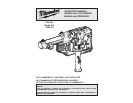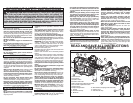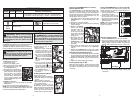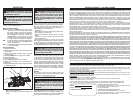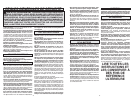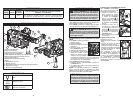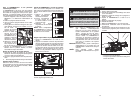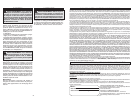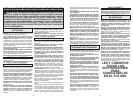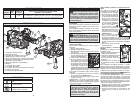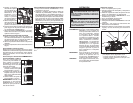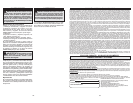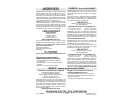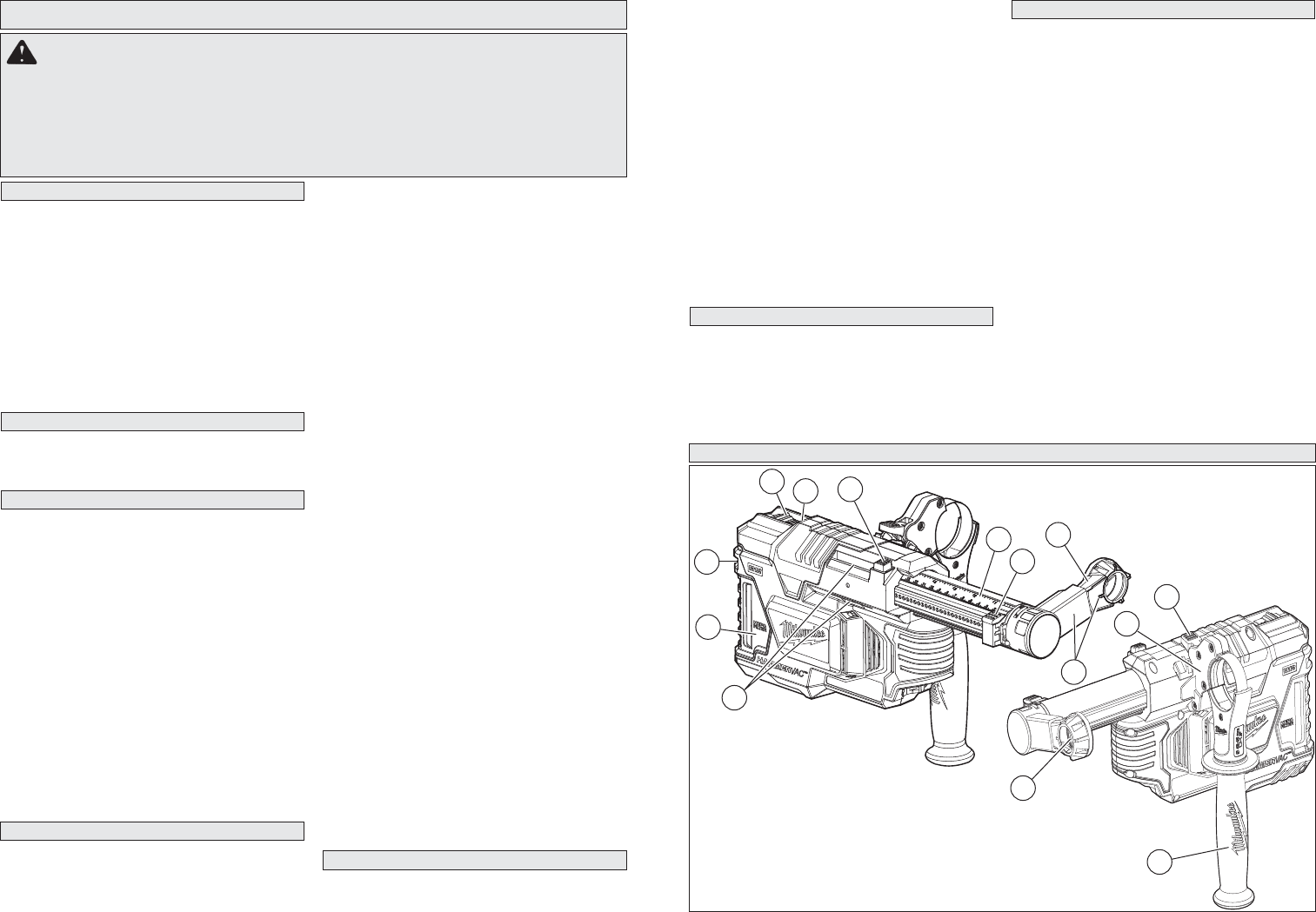
2 3
IMPORTANT SAFETY INSTRUCTIONS
• Keep work area clean and well lit. Cluttered or
dark areas invite accidents.
• Dust extractors have motors and other parts
that can produce sparks during normal use.
Do not use within 30 feet of areas where explosive
materials may be present (such as gasoline pumps
and places where liquids like paint thinners, clean-
ers, solvents, etc. are stored).
• Do not use in the presence of explosive dust,
liquids or vapors.
• Do not use where oxygen or anesthetics are
used.
• Do not allow to be used as a toy. Close attention
is necessary when used by or near children.
• Use extra care when using on stairs.
• Do not pick up wet material. Do not use water
to settle dust.
• Do not handle battery pack or dust extractor
with wet hands.
• Do not pick up anything that is burning or
smoking such as cigarettes, matches, or hot
ashes.
• Do not pick up soot, cement, plaster or drywall
dust without fi lter in place. These are very fi ne
particles that may affect the performance of the
motor or be exhausted back into the air.
• To reduce the risk of health hazards from va-
pors or dust, do not vacuum toxic, carcinogenic
or other hazardous materials such as asbestos,
arsenic, barium, beryllium, lead, pesticides or other
health endangering materials.
• WARNING: Some dust created by power sanding,
sawing, grinding, drilling, and other construction
activities contains chemicals known to cause
cancer, birth defects or other reproductive harm.
Some examples of these chemicals are:
• lead from lead-based paint
• crystalline silica from bricks and cement and other
masonry products, and
• arsenic and chromium from chemically-treated
lumber.
Your risk from these exposures varies, depending
on how often you do this type of work. To reduce
your exposure to these chemicals: work in a well
ventilated area, and work with approved safety
equipment, such as those dust masks that are spe-
cially designed to fi lter out microscopic particles.
• Use special care when emptying heavily loaded
tanks.
• To avoid spontaneous combustion, empty dust
box after each use.
• Do not leave dust extractor unattended when
battery pack is installed. Remove battery pack
when not in use and before servicing.
• Do not put any object into openings. Do not use
with any opening blocked; keep free of dust, lint,
hair, and anything else that may reduce air fl ow.
• Maintain dust extractor. Check for misalign-
ment or binding of moving parts, breakage of
parts and any other condition that may affect
the dust extractor's operation. If damaged, have
the dust extractor repaired before use. Many
accidents are caused by poorly maintained tools.
• Maintain labels and nameplates. These carry
important information. If unreadable or missing,
contact a MILWAUKEE service facility for a free
replacement.
• Use dust extractor only with specifi cally des-
ignated battery packs. Use of any other battery
packs may create a risk of injury and fi re.
PERSONAL SAFETY
WORK AREA SAFETY
ELECTRICAL SAFETY
WARNING WHEN USING AN ELECTRICAL DUST EXTRACTOR,
BASIC PRECAUTIONS SHOULD ALWAYS BE FOLLOWED, INCLUDING THE
FOLLOWING: READ ALL INSTRUCTIONS BEFORE USING DUST EXTRAC-
TOR. FOR HOUSEHOLD OR COMMERCIAL USE. BEFORE USING THE DUST
EXTRACTOR, READ THIS OPERATOR’S MANUAL, YOUR TOOL, BATTERY
PACK AND CHARGER OPERATOR’S MANUALS, AND ALL LABELS ON THE
DUST EXTRACTOR, BATTERY PACK, CHARGER AND TOOL.
USE AND CARE
BATTERY PACK USE AND CARE
• STAY ALERT. Watch what you are doing and use
common sense. Do not use dust extractor when you
are tired, distracted or under the infl uence of drugs,
alcohol or medication causing diminished control.
• The operation of a dust extractor can result in
foreign objects being blown into eyes, which can
result in eye damage. Always wear safety goggles
or glasses with side shields when operating dust
extractor.
• Wear a face or dust mask when working in dust
situations. Dust particles can harm your lungs.
• Avoid accidental starting. Ensure the switch is
in the off-position before inserting battery pack.
Inserting battery pack in dust extractor that has the
switch on invites accidents.
• Do not overreach. Keep proper footing and
balance at all times. This enables better control
of the dust extractor in unexpected situations.
• Keep hair, loose clothing, fi ngers, and all parts
of body away from openings and moving parts.
• Use only as described in this manual. Use only
manufacturer’s recommended attachments.
• Do not use without dust box and/or fi lter in
place.
• Do not use to pick up fl ammable or combustible
liquids such as gasoline or use in areas where they
may be present.
READ AND SAVE ALL INSTRUCTIONS
FOR FUTURE USE
• Turn off all controls before removing battery pack.
• To reduce the risk of electric shock, do not use
on wet surfaces. Do not expose to rain. Store
indoors.
• Before using the battery pack or charger read
the operator’s manuals, and any labels on the
battery pack, charger and dust extractor.
• Recharge only with the charger specifi ed by
the manufacturer. A charger that is suitable for
one type of battery pack may create a risk of fi re
when used with another battery pack.
• When battery pack is not in use, keep it away
from other metal objects like paper clips, coins,
keys, nails, screws, or other small metal objects
that can make a connection from one terminal
to another. Shorting the battery terminals together
may cause burns or a fi re.
• Do not use damaged battery pack or dust
extractor. If battery pack or dust extractor are not
working as they should, have been dropped, dam-
aged, left outdoors, or dropped into water, return
them to a service center.
SERVICE
• Have your power tool serviced by a qualifi ed
repair person using only identical replacement
parts. This will ensure that the safety of the power
tool is maintained.
SPECIFIC SAFETY RULES
•Before using the dust extractor, read this op-
erator’s manual, your tool, battery pack and
charger operator’s manuals, and all labels
on the dust extractor, battery pack, charger
and tool.
• Always use side handle assembly with the
correct neck diameter for the rotary hammer/
hammer drill. An ill-fi tting side handle will not
tighten securely, causing loss of control.
• Never use dust extractor without dust box and
HEPA fi lter in place. Never use water to clean
dust box or HEPA fi lter.
• Wear ear protectors. Exposure to noise can
cause hearing loss.
• Always use side handle provided with dust
extractor when using with a rotary hammer/
hammer drill. When dust extractor is removed
from the tool, always use side handle(s) sup-
plied with the tool. Loss of control can cause
personal injury.
• Hold power tool by insulated gripping sur-
faces, when performing an operation where the
fastener may contact hidden wiring. Fasteners
contacting a “live” wire may make exposed metal
parts of the power tool “live” and could give the
operator an electric shock.
FUNCTIONAL DESCRIPTION
1. Power Switch
2. Fuel Gauge
3. Dust Box Latch
4. Dust Box with Filter
5. Side Handle Clamp Attachment Point
6. Tool and Bit Adjustment Button
7. Depth Gauge
8. Depth Gauge Button
9. Nozzle
10. Nozzle Assembly
11. Bit Brush
6
7
11
5
9
8
4
1
12
3
2
13
14
12. Side Handle Clamping Collar Assembly
13. Clamp Lever
14. Side Handle Grip
10



